
Maitreya
MAITREYA, the Future Buddha whose name means “loving kindness,” is a very active Bodhisattva, Buddhist tradition says, involved intimately with the Earth.
We saw in the story of Asanga, how closely Maitreya was in his relationship with his chela.
Not only did this boost Asanga’s spiritual progress, but that propelled him to a point where he could serve as the amanuensis for Maitreya’s teaching written in the fourth century A.D.
Maitreya is a Tathagatha (the Absolute come), which, Helena Blavatsky explains, “is the highest epithet, since the first and the last Buddhas were the direct immediate avatars of the first deity.”
Fascinating that this Future Buddha is so present with us, and reams of testimony in the ancient East bear witness to his personal intercession, sometimes through statues of him, for healing, compassion, forgiveness, teaching, and initiation.
Point of Grace
This intercession is purely a point of grace, for humanity, Helena Blavatsky explains:
“… having fallen into matter, their spiritual vision became dim; and coordinately the third eye commenced to lose its power ….The Inner sight could henceforth be acquired only through training and initiation…” (Secret Doctrine 2:294).
Master K.H. reveals in the Mahatma Letters:
“Our Lord Buddha…would not have appeared in our epoch, great as were his accumulated merits in previous rebirths but for a mystery….” (Letter XV, p. 96).
To understand where, as individuals, we fit into all of this, we’ll explore Maitreya a bit more, and his and our creation in the Dhyani Buddhas.
 Maitreya
Maitreya
The Fifth Buddha
In the Secret Doctrine, Madame Blavatsky expounds on the symbolism of the letter “M,” noting that “Maitreya is the secret name of the Fifth Buddha…the last Messiah who will come at the culmination of the Great Cycle.”(I:184):
Vajrayana Buddhism outlines five distinctive ages presided over and involving three types of beings: a Dhyani Buddha, a Dhyani Bodhisattva, and an incarnate Buddha. The transcendent Dhyani Buddhas and their counterparts symbolize aspects of enlightened consciousness as emanations of one single primordial Buddha. Think of them as types of step-down transformers conveying divine frequencies for assimilation and transformation.
According to this Vajrayana scheme, we currently reside in the fourth age of the Dhyani Buddha Amitabha, the Dhyani Bodhisattva Avalokiteshvara (Guan Yin or Kuan Yin), and the incarnate Buddha Shakyamuni. The fifth age would be presided over by the Dhyani Buddha Amoghasiddhi, the Dhyani Bodhisattva Vishvapani, and the incarnation of Maitreya Buddha.

Amoghasiddhi
“[W]e are still in the Fourth Round, and the world also has only had four Buddhas, so far,” Madame Blavatsky explains, “But as every new Root-race at the head of a Round must have its revelation and revealers, the next Round will bring the Fifth, the following the Sixth, and so on.”
Born of Stars:Dhyani Buddhas
Madame Blavatsky, however, asserts there are seven Dhyani Buddhas and offers this insight for how each one of us is under the “star” of a distinct Dhyani Buddha:
“In the esoteric, and even exoteric Buddhism…Adi Buddha …the One unknown, without beginning or end… emits a bright ray from its darkness.
 Logos Buddha’s Diamond Heart
Logos Buddha’s Diamond Heart
“This is the Logos (the first), or…the Supreme Buddha…As the Lord of all Mysteries he cannot manifest, but sends into the world of manifestation his heart — the ‘diamond heart,’…
“This is the second logos of creation, from whom emanate the seven (in the exoteric blind the five) Dhyani Buddhas…
“These Buddhas are the primeval monads from the world of incorporeal being…wherein the Intelligences (on that plane only) have neither shape nor name, in the exoteric system, but have their distinct seven names in esoteric philosophy….
Buddha Here, Buddha There

“In the [Vajrayana] Buddhist system, or the popular exoteric religion, it is taught that every Buddha, while preaching the good law on earth, manifests himself simultaneously in three worlds: in the formless, as Dhyani Buddha, in the World of forms, as a Bodhisattva, and in the world of desire, the lowest (or our world) as a man.
“Esoterically the teaching differs: The divine, purely Adi-Buddhic monad manifests as the universal Buddhi [universal soul or mind,] the spiritual, omniscient and omnipotent root of divine intelligence, … or the Logos.
“This descends ‘like a flame spreading from the eternal Fire, immoveable, without increase or decrease, ever the same to the end’ of the cycle of existence, and becomes universal life on the Mundane Plane.
“From this Plane of conscious Life shoot out, like seven fiery tongues, the Sons of Light (the logoi of Life); then the Dhyani-Buddhas of contemplation: the concrete forms of their formless Fathers — the Seven Sons of Light…”
 Bodhisattvas’ Birth
Bodhisattvas’ Birth
“These Dhyani Buddhas emanate, or create from themselves…celestial Selves — the super-human Bodhisattvas. These incarnating at the beginning of every human cycle on earth as mortal men, become occasionally, owing to their personal merit, Bodhisattvas among the Sons of Humanity, after which they may re-appear as…Buddhas….”
Our Guiding Stars and Parents:
Dhyani Buddhas
Those formless Fathers of the Dhyani Buddhas, those “Seven Sons of Light” mentioned earlier are also called “Stars,” Madame Blavatsky explains in the same passage.
“The star under which a human Entity is born, says the Occult teaching, will remain for ever its star, throughout the whole cycle of its incarnations in one Manvantara.
“But this is not his astrological star. The latter is concerned and connected with the personality, the former with the individuality.
“The ‘Angel’ of that Star, or the Dhyani-Buddha will be either the guiding or simply the presiding “Angel,” so to say, in every new rebirth of the monad [that immortal incarnating part of you], which is part of his own essence….

Twin Souls and Planetary Spirits
“The adepts have each their Dhyani-Buddha, their elder “twin Soul,” and they know it, calling it ‘Father-Soul,’ and ‘Father-Fire.’ It is only at the last and supreme initiation, however, that they learn it when placed face to face with the bright ‘Image.’
“….the [monads, that is–you and me, as] radiations of one and the same Planetary Spirit (Dhyani Buddha) are, in all their after lives and rebirths, sister, or ‘twin-souls,’ on this Earth.
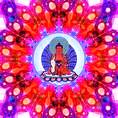 Whose Star Are You Born Under?
Whose Star Are You Born Under?
“This was known to every high Initiate in every age and in every country: ‘I and my Father are one,’ said Jesus [and] When He is made to say, elsewhere …‘I ascend to my Father and your Father,’ it meant that which has just been stated.
“It was simply to show that the group of his disciples and followers attracted to Him belonged to the same Dhyani Buddha, “Star,” or “Father,” again of the same planetary realm and division as He did.”
In mainstream Buddhism, this is referred to as being a part of a Buddha “family.”
Which of the Dhyani Buddha families are you a member of?
 Can We Get There from Here?
Can We Get There from Here?
Going back to Maitreya, we can understand why he sought to restore the ancient wisdom of the original Buddha’s teaching through his chela Asanga through the new school called Yogacharya. Similar to the role the Mahatmas and Helena Blavatsky fulfilled in the founding of Theosophy in the hope of getting us back on track.
Maitreya sought to restore the ancient wisdom of the original Buddha’s teaching through his chela Asanga, and that intention was the impetus behind the founding of the Yogacharya school of Buddhism. Similar to the role the Mahatmas and Helena Blavatasky fulfilled in the founding of Theosophy.
“From this living and presently acting body of [Mahatmas,] H.P.Blavatsky declared she received the impulse to once more bring forward the old ideas, and from them also received several keys to ancient and modern doctrines that had been lost during modern struggles toward civilization,” William Q. Judge explains, “and also that she was furnished by Them with some doctrines really ancient but entirely new to the present day in any exoteric shape.”
The reassertion of Yogacharya teaching came at a time when misunderstandings about nirvana prevailed, viewing it as total nihilism. It is said that Asanga’s mother, a devotee of the Bodhisattva of Compassion Avalokiteshvara, was grieved by the “great misfortune that had befallen Buddhism” at the time in India and prayed to Him that she might be an instrument to restore the Dharma, says scholar Janice Willis. Thus, Asanga’s mother bore three sons who all dedicated their lives to Buddhism.

Asanga
You Create Reality
One hallmark of the Yogacharya school was the teaching on “Mind-Only” or Cittamatra. “Our entire experience of ‘subjective’ and ‘objective’ reality is nothing but a flow of (illusory) perceptions,” explains Richard Taylor, author of Blavatsky and Buddhism.
“Through sense-perceptions and inference, we construct our entire experience and perceive it to be objective and real–but it is really only our own construct. Since we are all doing this, there is something of a shared illusion, a shared dream. But it is not real. This illusory, constructed aspect is ‘vijnaptimatra.’ This is our experience, samsara, the basis for our confusion and suffering.
“In its pure, absolute aspect, the teaching is of a real, pure, permanent ‘substratum consciousness’ (alayavijnana). When confused, constructed consciousness that is tainted by personal desires ceases — the pure substratum consciousness is unveiled. It is not personal, but universal and eternal.”
The following excerpt from the film “What the Bleep Do We Know?” explores breaking away from this shared illusion and how one’s brain and body responds:
Error
This video doesn’t exist
A Word from HPB and Asanga
HPB quotes a teaching from Asanga on our true nature:
“THAT which is neither Spirit nor Matter. Light nor Darkness, but is verily the container and root of these, that thou art. The root projects at every Dawn its shadow of ITSELF, and that shadow thou callest Light and Life. O poor dead Form. (This) Life-Light streameth downward through the stairway of the seven worlds, the stairs of which with each step becomes denser and darker. It is of this seven-times-seven scale that thou art the faithful climber and mirror. O little man! Thou art this, but thou knowest it not.”
And then she comments:
“THIS is the first lesson to learn. The second is to study well and know the principles of both the Kosmos and ourselves, dividing the group into the permanent and impermanent, the higher and immortal, and the lower and mortal; for thus only can we master and guide the lower cosmic and personal, then the higher cosmic and impersonal. Once we can do that, we have secured our immortality.”
© Kara LeBeau 2009. All rights reserved.

Nicholas Roerich - "Star of the Hero"
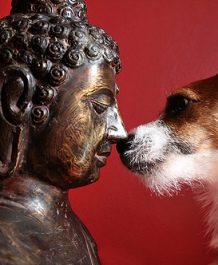
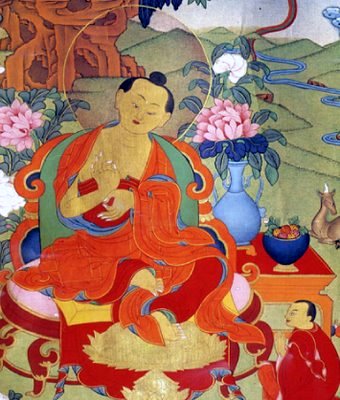


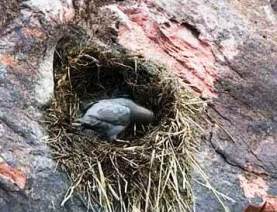


 Maitreya
Maitreya
 Logos Buddha’s Diamond Heart
Logos Buddha’s Diamond Heart
 Bodhisattvas’ Birth
Bodhisattvas’ Birth

 Can We Get There from Here?
Can We Get There from Here?





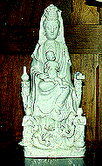
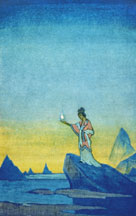
 © Kara LeBeau 2009 All rights reserved
© Kara LeBeau 2009 All rights reserved


